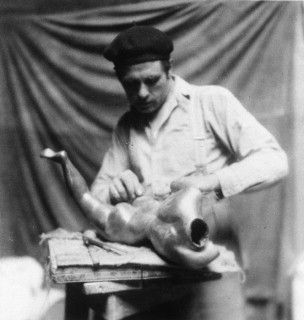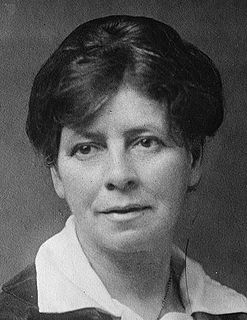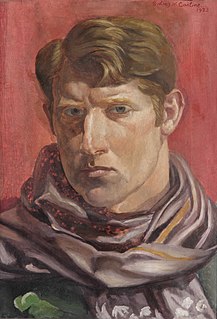Related Research Articles

George Claude Leon Underwood was a British artist, although primarily known as a sculptor, printmaker and painter, he was also an influential teacher and promotor of African art. His travels in Mexico and West Africa had a substantial influence on his art, particularly on the representation of the human figure in his sculptures and paintings. Underwood is best known for his sculptures cast in bronze, carvings in marble, stone and wood and his drawings. His lifetime's work includes a wide range of media and activities, with an expressive and technical mastery. Underwood did not hold modernism and abstraction in art in high regard and this led to critics often ignoring his work until the 1960s when he came to be viewed as an important figure in the development of modern sculpture in Britain.

Eric William Ravilious was a British painter, designer, book illustrator and wood-engraver. He grew up in Sussex, and is particularly known for his watercolours of the South Downs and other English landscapes, which examine English landscape and vernacular art with an off-kilter, modernist sensibility and clarity. He served as a war artist, and died when the aircraft he was in was lost off Iceland.

Lucy Elizabeth Kemp-Welch was a British painter and teacher who specialised in painting working horses. She is best known for the paintings of horses in military service she produced during World War One and for her illustrations to the 1915 edition of Anna Sewell's Black Beauty.

Leonard Rosoman was a British artist.
Helen Francesca Mary Binyon was a British artist and author. She was also a watercolour painter, an illustrator and a puppeteer.
Rosemary "Ray" Howard-Jones was a prolific Welsh painter best known for her impressionistic seascapes and paintings of the coastline of Wales, particularly of the areas around Skomer and Marloes.
Stephen Bone was an English painter, writer, broadcaster and noted war artist. Bone achieved early success in book illustration using woodcuts before he turned to painting and art criticism.
Claude Maurice Rogers was a British painter of portraits and landscapes, an influential art teacher, a founding member of the Euston Road School and at one time the President of the London Group of British artists.

John Finnie was a Scottish landscape painter and engraver. He was best known in London for his original mezzotint engravings of landscape, and exhibited at the Royal Academy and the Royal Society of Painters, Etchers, and Engravers. When he moved to Towyn in northern Wales he painted numerous landscape paintings of places in the Capel Curig area, such as Snowdon. He was headmaster of the Liverpool Mechanics Institute and School of Art from 1855 until 1896. Several paintings related to him are on display in the Walker Art Gallery in Liverpool and the Portsmouth Museum.
Victorine Anne Foot was a British artist who worked in oils, watercolours and pastels. Foot is best known for her work during World War II on military camouflage and for her post-war career as an artist and teacher in Scotland.

Sydney William Carline was a British artist and teacher known for his depictions of aerial combat painted during World War One.

Archibald Standish Hartrick was a Scottish painter known for the quality of his lithographic work. His works covered urban scenes, landscapes and figure painting and he was a founder member of the Senefelder Club.
James Cowie was a Scottish painter and teacher. The quality of his portrait paintings and his strong linear style made him among the most individual Scottish painters of the 1920s and 1930s. His work displayed meticulous draughtsmanship which was based on his studies of the Old Masters and his use of many preparatory drawings.
Edmond Xavier Kapp was a British portrait painter, draughtsman and caricaturist who during his career depicted many of the most famous politicians, artists and musicians of the time.
Charles Alfred Mozley was a British artist who was also a teacher. He was a prolific book illustrator and designer of book covers, posters and prints.
Thomas James Carr was an Irish artist who was associated with the Euston Road School in the 1930s and had a long career as a painter of domestic scenes and landscapes.
Edgar Ainsworth (1905-1975) was a British artist, poster designer and magazine illustrator, who is known for the drawings he made at the Bergen-Belsen concentration camp in the months following the camps' liberation by the British Army in 1945.
Eric Wilfred Taylor was a British artist and teacher. Although he had a long career encompassing painting, printmaking and the production of sculptures, murals, and ceramics, he is now perhaps best known for the works he created during the Second World War and in particular the paintings he produced when he was among the British troops that liberated the Bergen-Belsen concentration camp.
Joy Claire Allison Dalby is a British artist and book illustrator who mainly depicts botanical subjects and who works in watercolours, gouache and wood engraving.
Elizabeth Gulland was a Scottish-born engraver and painter.
References
- 1 2 3 4 5 David Buckman (1998). Artists in Britain Since 1945 Vol 1, A to L. Art Dictionaries Ltd. ISBN 0 95326 095 X.
- 1 2 3 4 Alan Horne (1994). The Dictionary of 20th Century British Book Illustrators. Antique Collectors' Club. ISBN 1 85149 1082.
- 1 2 3 4 Royal Museums Greenwich. "Cook, John Kingsley". Royal Museums Greenwich. Retrieved 27 September 2017.
- 1 2 Rebbeca Onion (2 April 2014). "One Sailor's Sketched Memories of a World War II Shipwreck". Slate. Retrieved 27 September 2017.
- ↑ Imperial War Museum. "Correspondence with artists:John Kingsley Cook". Imperial War Museum . Retrieved 27 September 2017.
- ↑ "Church Architecture". St Teresa's Parish Community Website. 2019. Retrieved 22 January 2019.
- ↑ Peter J.M. McEwan (1994). The Dictionary of Scottish Art and Architecture. Antique Collectors' Club. ISBN 1 85149 134 1.